Bio Ch. 8 (-3) & Ch. 9
1/120
There's no tags or description
Looks like no tags are added yet.
Name | Mastery | Learn | Test | Matching | Spaced |
|---|
No study sessions yet.
121 Terms
What factors influence membrane fluidity?
fluid-mosaic characteristics (?)
type of fatty acids in the phospholipids
cholesterol
temperature
How do the fluid-mosaic characteristics affect fluidity
the “mosaic” arrangement means that it can adapt more easily and self seal if disrupted. It makes it more flexible as a whole
How does the type of fatty acid in phospholipids affect fluidity of the membrane
saturated = straight, make a dense & rigid membrane
unsaturated = bent and don’t pack as tightly (makes it more flexible)
how does cholesterol affect membrane fluidity
cholesterol lipids lessen the effects of temperature on the membrane by acting as a buffer
extends the range of temperature it can function properly in
how does temperature influence membrane fluidity
higher temperatures increase fluidity - moves more freely, which creates a “more fluid state” that lipids and proteins can move laterally within more easily
lower temperatures decrease - less movement, more rigid, less fluid, more tightly packed together
The amphipathic nature of plasma membranes makes the membrane ________ _________
selectively permeable
How does the amphipathic nature of plasma membranes make it selectively permeable & what does that mean
the membranes have both hydrophobic and hydrophilic regions, which allows for some things to get through and others to not
what CAN get through the hydrophobic areas of the membrane (and examples)
small, lipid-soluble substances
hydrophobic gases like O2 and CO2
fat soluble vitamins (A, D, E, K)
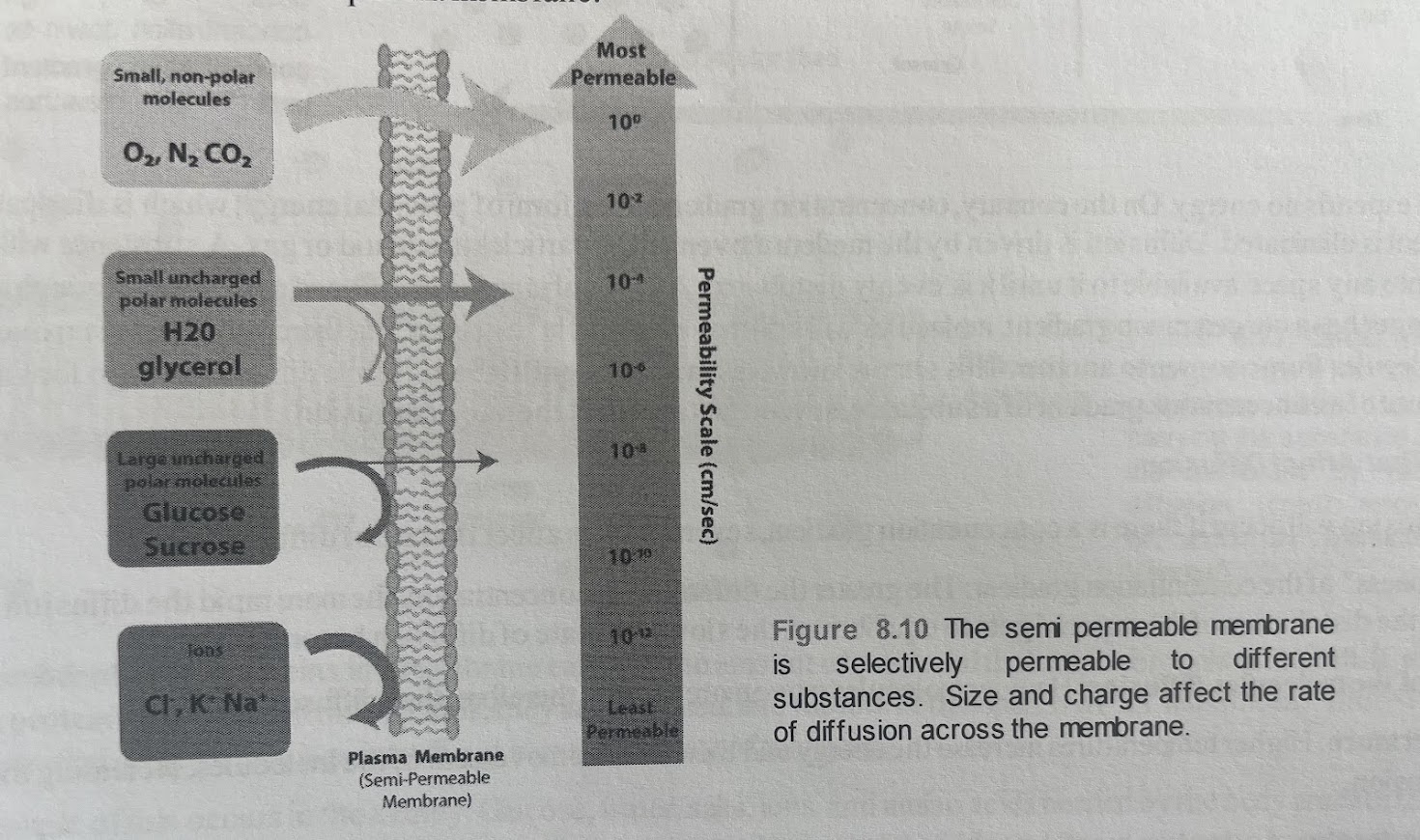
what CANT get through the membrane (and examples)
hydrophilic substances
polar, charged, ions
large polar molecules (monosaccharides & amino acids)
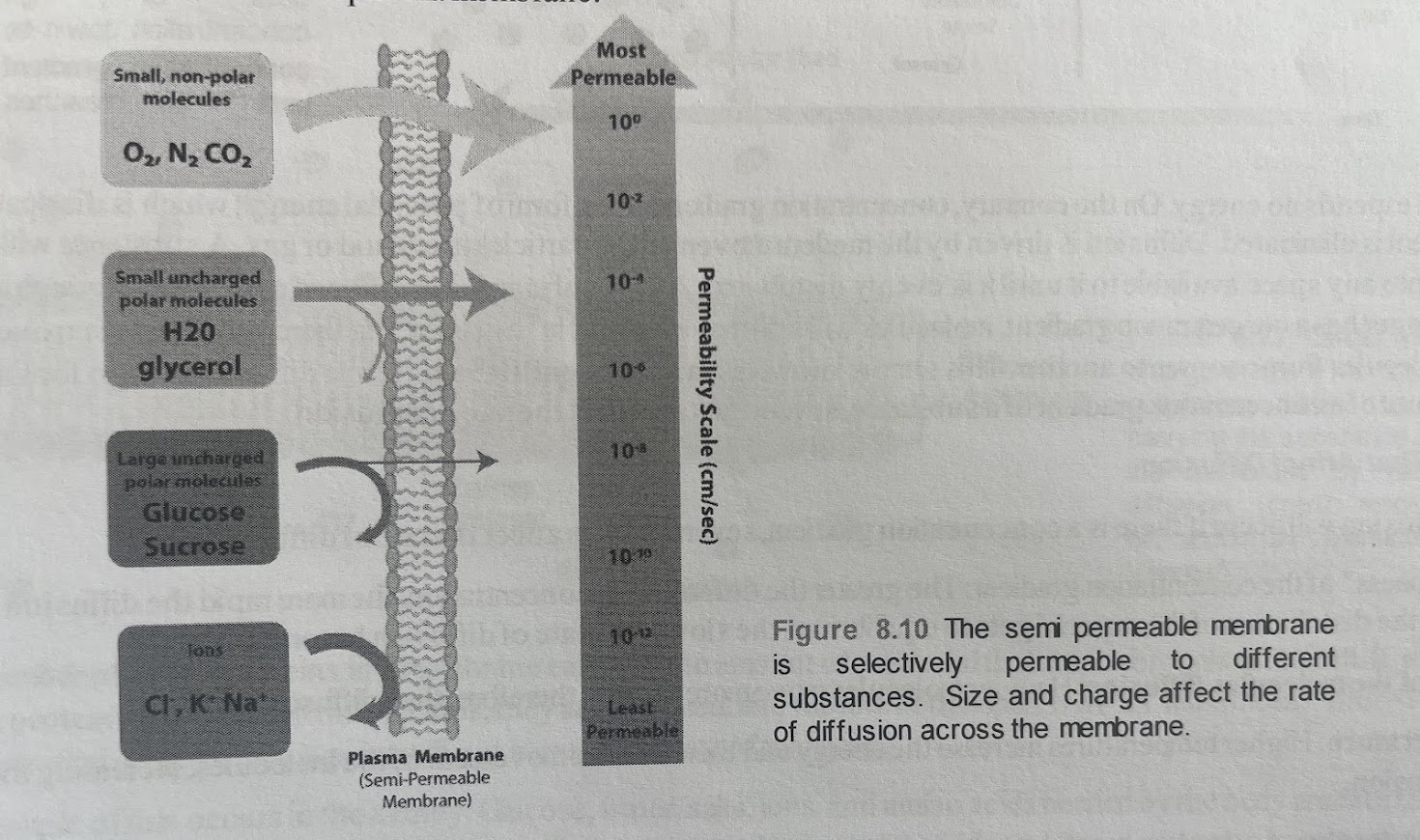
When is passive transport used?
substance moves high —> low concentration
does passive transport require energy
nope!
when is active transport used
substance moves from low —> high concentration
does active transport require energy
yes
Is diffusion active or passive
passive
what is a concentration gradient
a range of concentrations across a space/the difference in the concentration of a substance between areas
substances typically move from areas of ______ concentration to areas of _____ concentration
high —> low
what is dynamic equilibrium
state where systems maintain stability despite continuous internal changes
just a more specific version of homeostasis
Factors that affect diffusion:
“steepness” of the concentration gradient
mass of the molecules diffusing
temperature
solvent density
how does the “steepness” of the concentration gradient affect diffusion
the greater the difference in concentration, the faster diffusion happens
the closer the distribution of the material gets to the equilibrium, the slower it happens
how does the mass of the molecules diffusing affect diffusion
heavier molecules move slower and therefore diffuse more slowly
how does temperature affect diffusion
higher temps = increased energy and movement of molecules, so faster diffusion
how does solvent density affect diffusion
as density ↑ rate of diffusion ↓
molecules slow down because they have a harder time getting through a denser area
if the area is less dense diffusion increases
What is facilitated diffusion
diffusion with the help of membrane proteins
What are the membrane proteins for facilitated diffusion
channel and carrier proteins
why is facilitated diffusion sometimes required
for polar or charged molecules that can’t get through the phospholipid bilayer directly
how do the proteins help these molecules get through the bilayer
they shield them from the repulsive force of the membrane
Which protein do ions use for facilitated diffusion
channel proteins (because they are small and charged)
What protein do larger polar molecules like glucose and amino acids diffuse through (facilitated diffusion)
carrier proteins
What part of channel proteins is hydrophobic and which part is hydrophilic
hydrophobic = the exterior/part that interacts with the phospholipid bilayer
hydrophilic = interior “channel” is hydrophilic
what is the most common type of channel protein
ion channels
Can an ion channel work for multiple ion types
no, each ion channel is specific to one type of ion
What is the difference between an “open” ion channel protein and a “gated” one
“open” = always open
“gated” = can be opened or closed
How do “ligand-gated” channels work
the attachment of a particular molecule to the channel protein may cause it to open
how do “voltage-gated” channels work
they require a change in voltage across the membrane to open them
What cells have voltage gated channels in their membranes
cells involved in the transmission of electrical impulses
nerve & muscle cells
what are aquaporins
channel proteins that allow water to pass through the membrane at a very high rate
What molecules use carrier proteins (and examples)
molecules that are too large to pass through channels
amino acids & glucose
what happens when a substance binds to its carrier protein?
A shape change is triggered that moves the bound molecule across the membrane
What does it mean when all carrier proteins are bound to their ligands and are saturated?
the rate of transport is at its maximum
will the rate of transport change if you increase the concentration gradient when all carrier proteins are bound to their ligands and are saturated?
nope! everything’s already at its max
what do glucose transport proteins (GLUTs) do
transport glucose and other sugars into the cell
what kind of proteins are glucose transport proteins (GLUTs)?
carrier proteins
are carrier proteins or channel proteins faster means of transportation
channel proteins
what is osmosis
diffusion of water across a semipermeable membrane
what is the relationship between amount of water and solute concentration
“inversely proportional”
the higher the water concentration, the lower the solute concentration (and vice versa)
which direction does water move in terms of concentration
water moves from a high concentration of water to a low concentration of water
where there’s less water, that’s where it goes
What is tonicity
the ability of a solution to cause a cell to gain or lose water depending on the relative concentrations of solute inside and outside of the cell
a comparison between the solute concentration inside the cell and outside of it
what is osmolarity and what does it influence
the total concentration of dissolved solute particles per liter of solution/the total solute concentration of the solution
influences water movement across membranes and cell volume
what does it mean if a solution has a low osmolarity
there is more water relative to the solute
(like hypotonic but all within the cell, just compares internal substances)
what does it mean if a solution has a high osmolarity
there is less water relative to the solute
(like hypertonic but within the cell itself, just compares internal substances)
What 3 terms describe the comparison between the osmolarity of a cell to the osmolarity of the extracellular fluid?
hypotonic
hypertonic
isotonic
hypotonic definition and which direction does water move
solution outside of the cell has a lower solute concentration/more water
water moves down the concentration gradient and go into the cell to dilute it
hypertonic definition and which direction does water move
solution outside of the cell has a greater solute concentration/less water
water moves out of the cell
isotonic definition and which direction does water move
iso = same —> they have the same osmolarity (concentration) both inside and outside of the cell
How does the cell wall in plants, fungi, bacteria, and some protists help the cell from lysing (bursting)
the inflow of water produces turgor pressure that stiffens the cell walls
plasmolysis
the a plant is not watered the extracellular fluid will become hypertonic and the plant cell will shrink within its cell wall
what is the turgor pressure equivalent in protists that don’t have cell walls
contractile vacuoles that pumps out excess water
Does active transport require energy
yes
when is active transport used
if a substance has to move against the concentration gradient to get into the cell
what is active transport
the movement of solutes (not water) across a membrane against their concentration gradient
which direction do solutes move in active transport in terms of concentration
solutes move from a lower concentration to a higher concentration area
VERY basic explanation of active transport
pushing a rock uphill takes more energy and effort because you’re fighting gravity
what type of energy do cells typically use for active transport
ATP
difference between hypo/hpertonic movement and active transport movement
hypo/hypertonic movement moves water from areas with lots of water to areas with less water (adding water to juice to make it less strong)
active transport moves solute from areas of less solute to areas with more solute (pushing more people into a crowded area)
What is an electrical gradient
a difference of charge across the plasma membrane
what causes the electrochemical gradient
ions move in and out of cells but cells have proteins that don’t move and are mostly negatively charged
is the inside of living cells more electrically negative or positive compared to the extracellular fluid
electrically negative
Do cells have a higher or lower concentration of sodium ions than the extracellular fluid
lower concentration of Na+
what does it mean that the inside of cells has a greater electronegativity and a lower concentration of Na+
both the concentration gradient and electrical gradient tend to drive Na+ into the cell (????)
Do cells have a higher or lower concentration of potassium ions than the extracellular fluid
higher
what happens since there is a higher K+ concentration inside cells
the concentration gradient pushes K+ out of the cell while the electrical gradient pushes it into the cell
(wut)
What is the electrochemical gradient
the combined gradient of concentration and electrical charge that affects an ion
what protein does active transport use to work against the electrochemical gradient
pumps
what is the official term for the specific carrier proteins or pumps that facilitate active transport
transporters
what are the 3 types of transporters
uniporter
symporter
antiporter
what does a uniporter do in active transport
carries one specific ion or molecule
what does a symporter do in active transport
carries 2 different ions or molecules in the same direction
(sym means “together” or “with”)
what does an antiporter do in active transport
carries 2 different ions or molecules in different directions
(anti means “opposite”)
what kind of molecules can all 3 transporters carry
polar molecules like glucose against their gradient
picture of proteins for active transport
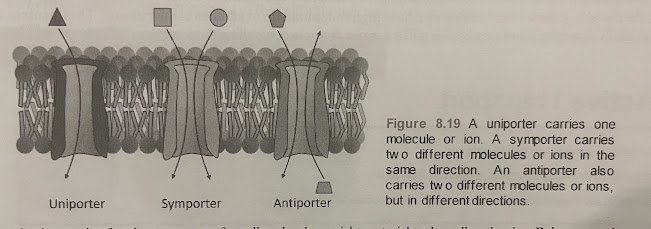
difference between primary active transport and secondary active transport (basic)
primary is directly dependent on ATP
secondary does not directly require ATP
why does secondary active transport not directly require ATP and what does this mean in terms of order of events
it uses electrochemical gradients established by primary active transport for fuel
means primary must occur first
why is the sodium-potassium pump important for cells
maintains the electrochemical gradient and the correct concentrations of Na+ and K+ on both sides of the cell membranes
is the sodium-potassium pump for animal cells or plant cells
animal
what active transport protein is the sodium-potassium pump
antiporter
What does the sodium-potassium pump do as an antiporter
moves 3 Na+ out of the cell and 2 K+ into the cell each cycle
Steps of the sodium-potassium pump (5 really long steps)
1.) 3 Na+ bind to the inside of the pump and ATP binds to the outside of the pump
2.) ATP attaches a phosphate group to the pump
3.) the pump changes shape and opens towards the outside of the cell and 3 Na+ are released from the cell
4.) 2 K+ attach to the inside of the pump, which causes the phosphate group to detach
5.) the pump changes back to its original shape and the 2 K+ are released into cytoplasm
Picture of the sodium-potassium pump
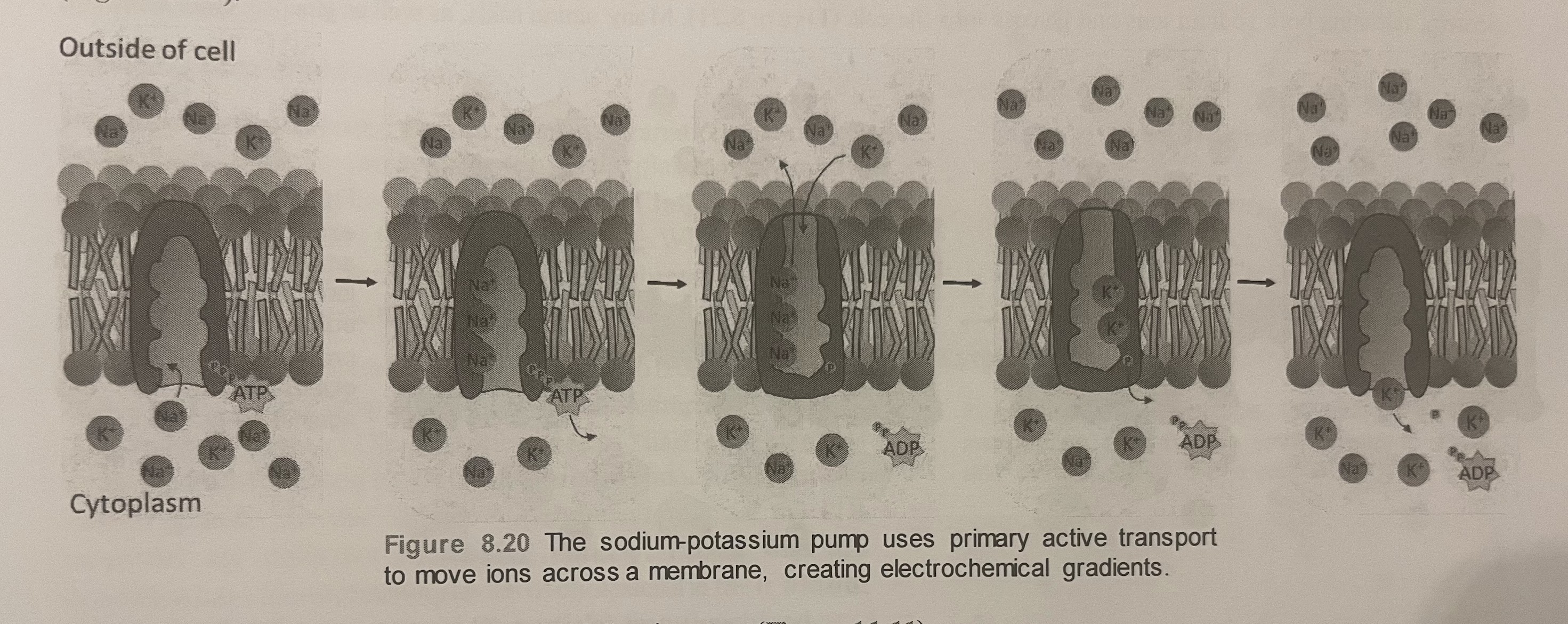
what is phosphorylation in the sodium-potassium pump example
in each cycle a phosphate group is transferred from ATP to the pump protein
what occurs as a result of phosphorylation in the sodium-potassium pump cycle
the pump protein changes shape, moving ions across the membrane
what is the definition of an electrogenic pump
a pump that creates an electrical imbalance across the membrane
What makes the sodium-potassium pump an electrogenic pump
because 3 Na+ move out as 2 K+ go in, the interior is slightly more negative than the exterior
what is the purpose of secondary active transport
to use ion gradients to bring substances like glucose and amino acids into the cell
Don’t know how to turn this into a question but it seems kinda important
“in one example of secondary active transport, cotransporter proteins bind to sodium ions and glucose on the outside of the cell. Sodium ions moving down their electrochemical gradient provide the energy to change the shape of the cotransporter protein, releasing both sodium ions and glucose into the cell”
what are vesicles used for and what is this process called
bringing large materials that can’t get through the membrane into and out of the cell
bulk transport
what are the types of bulk transport
endocytosis (not bolded = types of endocytosis)
phagocytosis
pinocytosis
receptor-mediated endocytosis
exocytosis
what is endocytosis and how does it work
moves particles such as large molecules, parts of cells, and even whole cells into a cell
the plasma membrane dents inward and creates a pocket that’s pinched off to become an intracellular vesicle
what is phagocytosis and how does it work
“cell eating” - large particles like other cells or relatively large particles are taken in by the cell
white blood cells eat invaders
surrounds and engulfs the microorganism
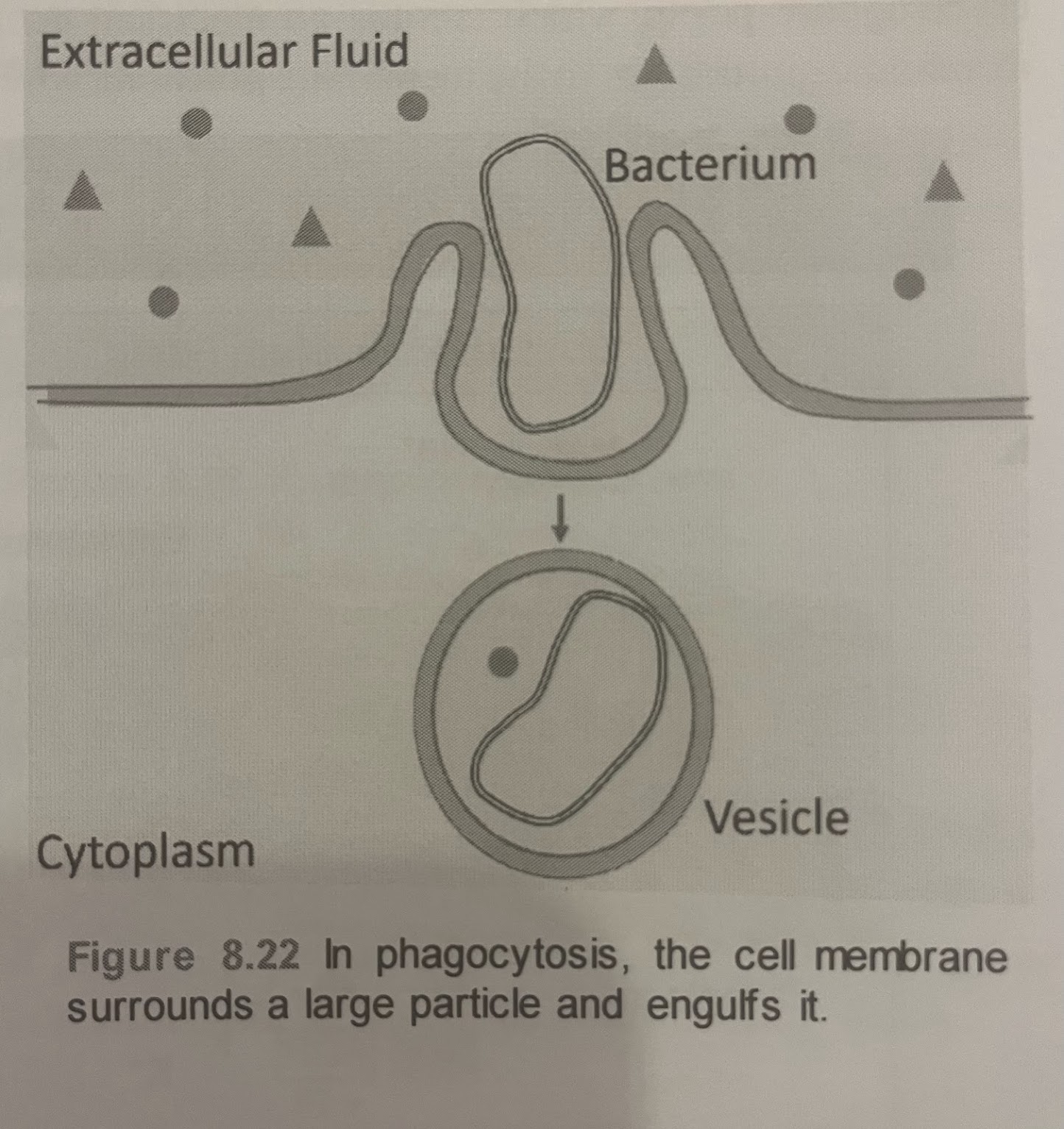
what is pinocytosis and how does it work
“cell drinking” - cells take in molecules that it needs from the extracellular fluid (including water)
results in a much smaller vesicle than phagocytosis and the vesicle does not need to merge with a lysosome after entering the cell
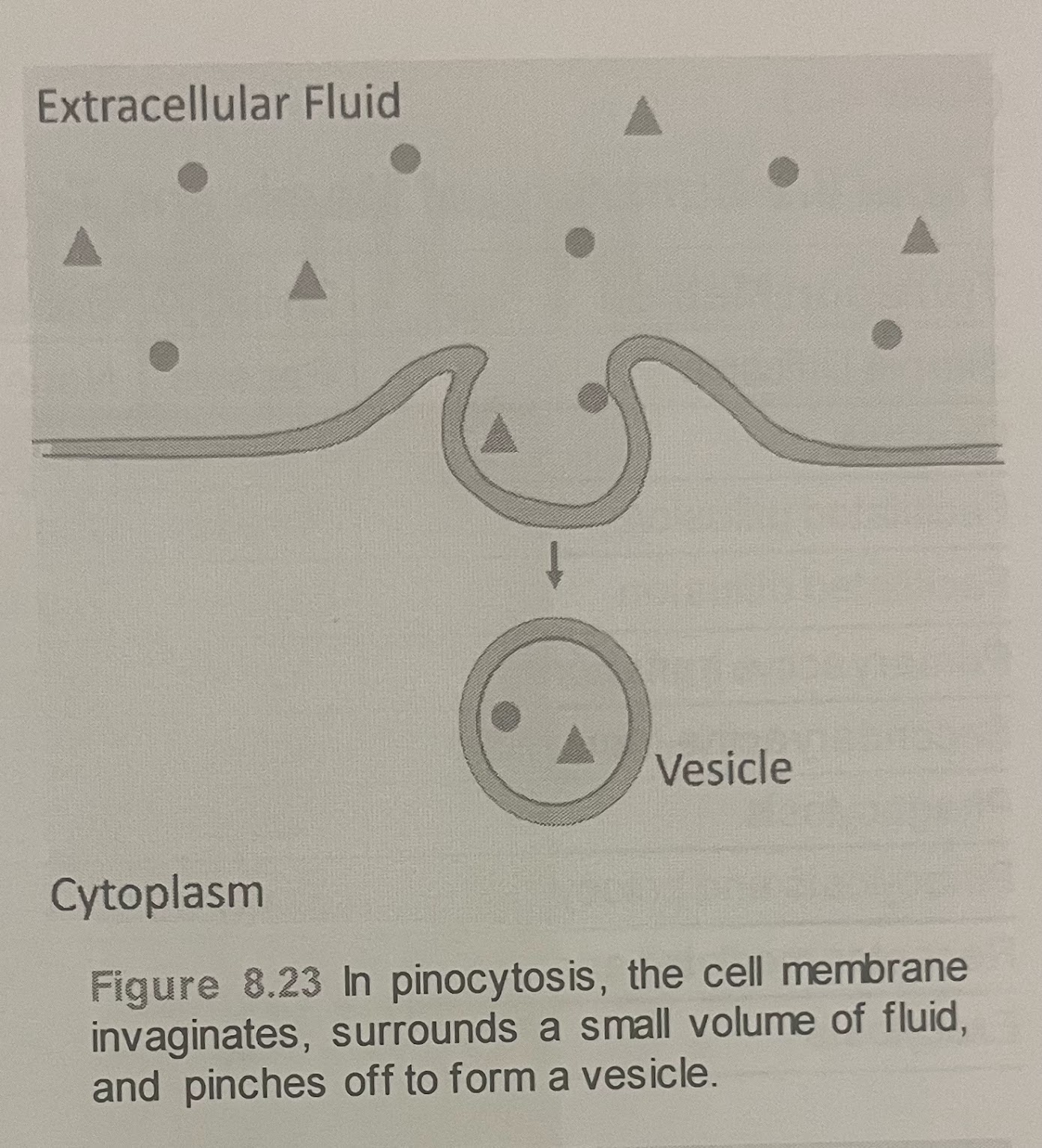
what is receptor-mediated endocytosis and how does it work
targeted variation of endocytosis that uses specific receptor proteins in the plasma membrane that bind to specific substrates
